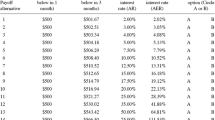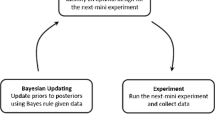Abstract
Subadditive time discounting means that discounting over a delay is greater when the delay is divided into subintervals than when it is left undivided. This may produce the most important result usually attributed to hyperbolic discounting: declining impatience, or the inverse relationship between the discount rate and the magnitude of the delay. Three choice experiments were conducted to test for subadditive discounting, and to determine whether it is sufficient to explain declining impatience. All three experiments showed strong evidence of subadditive discounting, but there was no evidence of declining impatience. I conclude by questioning whether hyperbolic discounting is a plausible account of time preference.
Similar content being viewed by others
References
Ainslie, George. (1975). “Specious Reward: A Behavioral Theory of Impulsiveness and Impulse Control,” Psychological Bulletin 82, 463–469.
Ainslie, George and Nick Haslam. (1992). “Hyperbolic Discounting.” In G. F. Loewenstein and J. Elster (eds.), Choice over Time. New York: Russell Sage Foundation.
Ayton, Peter. (1997). “How to be Incoherent and Seductive: Bookmakers' Odds and Support Theory,” Organizational Behavior and Human Decision Processes 72, 99–115.
Bateman, Ian, Alistair Munro, Bruce Rhodes, Chris Starmer, and Robert Sugden (1997). “Does Part-Whole Bias Exist? An Experimental Investigation,” The Economic Journal 107, 322–332.
Becker, Gary S. and Casey B. Mulligan. (1997). “The Endogenous Determination of Time Preference,” Quarterly Journal of Economics 112, 729–758.
Benzion, Uri., Amnon Rapaport, and Joseph Yagil. (1989). “Discount Rates Inferred from Decisions: An Experimental Study,” Management Science 35, 270–284.
Bjorkman, M. (1984). “Decision Making, Risk Taking, and Psychological Time: Review of Empirical Findings and Psychological Theory,” Scandinavian Journal of Psychology 25, 31–49.
Bohm-Bawerk, Eugen. (1888/1930). The Positive Theory of Capital. New York: G. E. Stechert and Co.
Chapman, Gretchen B. (1996). “Expectations and Preferences for Sequences of Health and Money,” Organizational Behavior and Human Decision Processes 67, 59–75.
Chapman, Gretchen B., and Arthur S. Elstein. (1995). “Valuing the Future: Temporal Discounting of Health and Money,” Medical Decision Making 15, 373–386.
Christensen-Szalanski, J. J. J. (1984). “Discount Functions and the Measurement of Patient's Values- Women's Decisions during Childbirth,” Medical Decision Making 4, 47–58.
Cohen, John, E. J. Dearnaley, and C. E. M. Hansel. (1956). “The Addition of Subjective Probabilities: The Summation of Estimates of Success and Failure,” Acta Psychologica 12, 371–380.
Fischhoff, Baruch, Paul Slovic, and Sarah Lichtenstein. (1978). “Fault Trees: Sensitivity of Estimated Failure Probabilities to Problem Representation,” Journal of Experimental Psychology: Human Perception and Performance 4, 330–344.
Fisher, Irving. (1930). The Theory of Interest. New York: Kelley and Millman.
Fraisse, Paul. (1964). The Psychology of Time. London: Eyre and Spotiswoode.
Fraisse, Paul. (1984). “Perception and Estimation of Time,” Annual Review of Psychology 35, 1–36.
Frank, Robert H. (1988). Passions within Reason: The Strategic Role of the Emotions. New York: W. W. Norton.
Frederick, Shane, and Baruch Fischhoff. (1997). “Scope Insensitivity at a Contingent Supermarket: Examining the Role of Familiarity in Scope Sensitivity,” Working Paper, Carnegie Mellon University.
Frederick, Shane, and Baruch Fischhoff. (1998). “Scope In sensitivity in Elicited Valuations,” Risk, Decision and Policy 3, 109–123.
Green, Leonard, Astrid Fry, and Joel Myerson. (1994). “Discounting of Delayed Rewards: A Life-Span Comparison,” Psychological Science 5, 33–36.
Green, Leonard, Joel Myerson, and E. McFadden. (1997). “Rate of Temporal Discounting Decreases with Amount of Reward,” Memory and Cognition 25, 715–723.
Hammond, Paul J. (1976). “Changing Tastes and Coherent Dynamic Choice,” Review of Economic Studies 43, 159–173.
Harvey, Charles M. (1994). “The Reasonableness of Non-Constant Discounting,” Journal of Public Economics 53, 31–51.
Hoch, Stephen, and George Loewenstein. (1991). “Time-Inconsistent Preferences and Consumer Self-Control,” Journal of Consumer Research 17, 492–507.
Holcomb, J. H., and P. S. Nelson. (1992). “Another Experimental Look at Individual Time Preference,” Rationality and Society 4, 199–220.
Humphrey, Steven J. (1995). “Regret Aversion or Event-Splitting Effects? More Evidence under Risk and Uncertainty,” Journal of Risk and Uncertainty 11, 263–274.
Humphrey, Steven J. (1996). “Do Anchoring Effects Underlie Event-Splitting Effects? An Experimental Test,” Economics Letters 51, 303–308.
Kahneman, Daniel, and Jack Knetsch. (1992). “Valuing Public Goods: The Purchase of Moral Satisfaction,” Journal of Environmental Economics and Management 22, 57–70.
Kirby, Kris N. (1997). “Bidding on the Future: Evidence Against Normative Discounting of Delayed Rewards,” Journal of Experimental Psychology: General 126, 54–70.
Kirby, Kris N., and Richard J. Herrnstein. (1995). “Preference Reversals Due to Myopic Discounting of Delayed Reward,” Psychological Science 6, 83–89.
Kirby, Kris. N., and Nina Marakovic. (1995). “Modeling Myopic Decisions: Evidence for Hyperbolic Delay-Discounting within Subjects and Amounts,” Organizational Behavior and Human Decision Processes 64, 22–30.
Koopmans, Tjalling, Peter A. Diamond, and Richard E. Williamson. (1964). “Stationary Utility and Time Perspective,” Econometrica 32, 82–100.
Laibson, David. (1997). “Golden Eggs and Hyperbolic Discounting,” Quarterly Journal of Economics 112, 443–477.
Loewenstein, George. (1988). “Frames of Mind in Intertemporal Choice,” Management Science 34, 200–214.
Loewenstein, George. (1992). “The Fall and Rise of Psychological Explanations in the Economics of Intertemporal Choice.” In G. F. Loewenstein and J. Elster (eds.), Choice over Time. New York: Russell Sage Foundation.
Loewenstein, George. (1996). “Out of Control: Visceral Influences on Behavior,” Organizational Behavior and Human Decision Processes 65, 272–293.
Loewenstein, George, and Drazen Prelec. (1992). “Anomalies in Intertemporal Choice: Evidence and an Interpretation,” Quarterly Journal of Economics 107, 573–597.
Loewenstein, George, and Drazen Prelec. (1993). “Preferences for Sequences of Outcomes,” Psychological Review 100, 91–108.
Loewenstein, George, and Richard Thaler. (1989). “Anomalies: Intertemporal Choice,” Journal of Economic Perspectives 3, 181–193.
Mazur, James. E (1984). “Tests of an Equivalence Rule for Fixed and Variable Reinforcer Delays,” Journal of Experimental Psychology: Animal Behavior Processes 10, 426–436.
Mazur, James E., and Richard J. Herrnstein. (1988). “On the Functions Relating Delay, Reinforcer Value, and Behavior,” Behavioral and Brain Sciences 11, 690–691.
Mulford, Matthew, and Robyn M. Dawes. (1999). “Subadditivity in Memory for Personal Events,” Psychological Science 10, 47–51.
Myerson, Joel, and Leonard Green. (1995). “Discounting of Delayed Rewards: Models of Individual Choice,” Journal of the Experimental Analysis of Behavior 64, 263–276.
Nesselroade, John R., Stephen M. Stigler, and Paul B. Baltes. (1980). “Regression Toward the Mean and the Study of Change,” Psychological Bulletin 88, 622–637.
Nozick, Robert. (1993). The Nature of Rationality. Princeton, NJ: Princeton University Press.
O'Donoghue, Ted, and Matthew Rabin. (2000). “The Economics of Immediate Gratification,” Journal of Behavioral Decision Making 13, 233–250.
Peterson, Dane K., and Gordon F. Pitz. (1988). “Confidence, Uncertainty and the Use of Information,” Journal of Experimental Psychology: Learning, Memory and Cognition 14, 85–92.
Poulton, E. C. (1989). Bias in Quantifying Judgments. Hove and London: Lawrence Erlbaum Associates.
Prelec, Drazen, and George Loewenstein. (1991). “Decision Making over Time and under Uncertainty: A Common Approach,” Management Science 37, 770–776.
Rachlin, Howard, and Leonard Green. (1972). “Commitment, Choice and Self-Control,” Journal of the Experimental Analysis of Behavior 17, 15–22.
Rachlin, Howard, and Andres Raineri. (1992). “Irrationality, Impulsiveness, and Selfishness as Discount Reversal Effects.” In G. F. Loewenstein and J. Elster (eds.), Choice over Time. New York: Russell Sage Foundation.
Raineri, Andres, and Howard Rachlin. (1993). “The Effect of Temporal Constraints on the Value of Money and Other Commodities,” Journal of Behavioral Decision Making 6, 77–94.
Read, Daniel, George Loewenstein, and Shobana Kalyanaraman. (1999). “Mixing Virtue and Vice: Combining the Immediacy Effect and the Diversification Heuristic,” Journal of Behavioral Decision Making 12, 257–273.
Read, Daniel and Barbara van Leeuwen. (1998). “Predicting Hunger: The Effects of Appetite and Delay on Choice,” Organizational Behavior and Human Decision Processes 76, 189–205.
Richards, Jerry B., Lan Zhang, Suzanne H. Mitchell, and Harriet de Wit. (1999). “Delay or Probability Discounting in a Model of Impulsive Behavior: Effect of Alcohol,” Journal of the Experimental Analysis of Behavior 71, 121–143.
Roelofsma, Peter H. M. P. and Daniel Read. (2000). “Subadditive Intertemporal Choice,” Journal of Behavioral Decision Making 13, 161–177.
Rottenstreich, Yuval, and Amos Tversky. (1997). “Unpacking, Repacking and Anchoring: Advances in Support Theory,” Psychological Review 104, 406–415.
Samuelson, Paul. (1937). “A Note on the Measurement of Utility,” Review of Economic Studies 4, 155–161.
Starmer, Chris V., and Robert Sugden. (1993). “Testing for Juxtaposition and Event-Splitting Effects,” Journal of Risk and Uncertainty 6, 235–254.
Stevens, S. S., and Hilda B. Greenbaum. (1966). “Regression Effects in Psychophysical Judgment,” Perception and Psychophysics 1, 439–446.
Strotz, R. H. (1955). “Myopia and Inconsistency in Dynamic Utility Maximization,” Review of Economic Studies 23, 165–180.
Thaler, Richard H. (1981). “Some Empirical Evidence on Dynamic Inconsistency,” Economic Letters 8, 201–207.
Tversky, Amos, and Derek J. Koehler. (1994). “Support Theory: A Nonextensional Representation of Subjective Probability,” Psychological Review 101, 547–567.
Varey, Carol A., Barbara A. Mellers, and Michael H. Birnbaum. (1990). “Judgments of Proportions,” Journal of Experimental Psychology: Human Perception and Performance 16, 613–625.
Weber, Martin, Franz Eisenfuhr, and Detlof von Winterfeldt. (1988). “The Effects of Splitting ¨ Attributes on Weights in Multiattribute Utility Measurement,” Management Science 34, 431–445.
Woodworth, Robert S., and Harold Schlosberg. (1954). Experimental Psychology, Revised Edition. London: Methuen.
Wright, George, and Peter Whalley. (1983). “The Supra-Additivity of Subjective Probability.” In B. P. Stigum, and F. Wenstø p (eds.), Foundations of Utility and Risk Theory with Applications. Dordrecht: D. Reidel Publishing Company.
Author information
Authors and Affiliations
Rights and permissions
About this article
Cite this article
Read, D. Is Time-Discounting Hyperbolic or Subadditive?. Journal of Risk and Uncertainty 23, 5–32 (2001). https://doi.org/10.1023/A:1011198414683
Issue Date:
DOI: https://doi.org/10.1023/A:1011198414683




